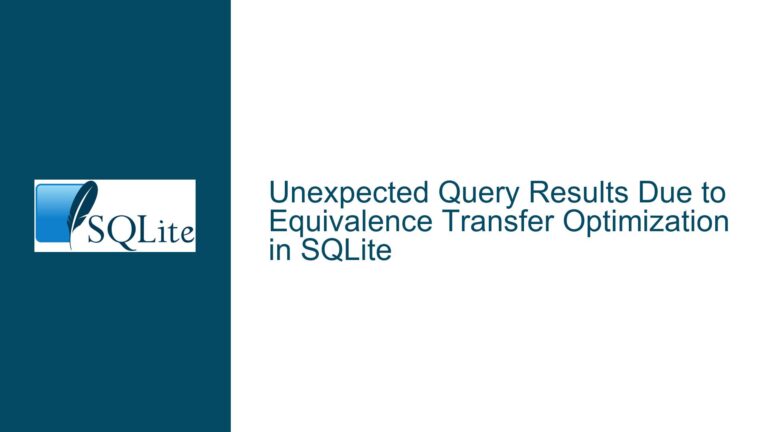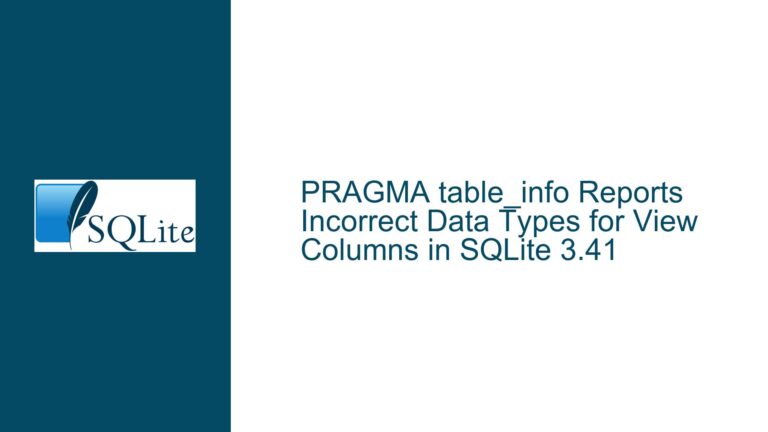Handling Edge Cases in LIKE Optimization with 256-Character ASCII and Virtual Tables
Character Encoding Mismatch in LIKE Clause Optimization for 256-ASCII Virtual Tables
UTF-8 to 256-ASCII Transcoding Challenges in LIKE Range Optimization
The core issue revolves around the interaction between SQLite’s UTF-8 text handling and a 256-character ASCII encoding system used by a legacy application through virtual tables. The problem manifests when executing LIKE queries with characters at the upper boundary of the 256-character set (character code 255 in 0-based indexing or 256 in 1-based systems). SQLite’s query optimizer converts LIKE 'char%' patterns to BETWEEN range comparisons for indexed columns, but this optimization fails when dealing with the maximum character value due to:
- Overflow errors when attempting to calculate
char+1beyond the 256-character limit - Lossy conversions between UTF-8 and the proprietary encoding
- Mismatched collation sequences between the virtual table’s native format and SQLite’s UTF-8 handling
The virtual table implementation uses conversion functions (fromUTF8()/toUTF8()) that cannot properly handle edge cases at character code 256, leading to invalid range calculations. This results in either:
- Empty result sets for valid queries
- Index scans becoming full table scans
- Data corruption during round-trip conversions
Boundary Overflow in Character Range Calculations
1. Encoding System Limitations
The 256-character ASCII implementation likely uses 8-bit storage (0-255 range) while presenting itself as 1-based (1-256) to users. SQLite’s UTF-8 handling assumes valid Unicode code points, creating three critical mismatches:
Character 256 Interpretation:
- As 0x100 in hexadecimal (beyond single-byte storage)
- Requires multi-byte UTF-8 encoding (0xC2 0x80 for U+0080)
- Loses fidelity when converted back to 8-bit storage
Collation Sequence Differences:
- Native sorting vs. UTF-8 binary comparison
- Case folding expectations
- Special character treatment (accented letters, control codes)
Range Calculation Overflow:
/* SQLite's internal range calculation pseudocode */ char *zPattern = "char%"; int cb = strlen(zPattern)-1; /* Exclude wildcard */ char upper[4]; memcpy(upper, zPattern, cb); upper[cb-1]++; /* Fails at 0xFF -> 0x100 overflow */This increment operation creates invalid upper bounds when applied to 0xFF (255 in 0-based) in 8-bit systems.
2. Virtual Table Interface Constraints
The virtual table implementation faces specific challenges through SQLite’s xBestIndex method:
Index constraint absorption:
- Must translate
LIKEconstraints to native range queries - Limited to SQLITE_INDEX_CONSTRAINT_LIMIT categories
- Cannot handle custom range adjustments for edge cases
- Must translate
Conversion function limitations:
/* Example problematic conversion */ char256_to_utf8(0xFF) => 0xC3 0xBF (UTF-8 for U+00FF) utf8_to_char256(0xC3 0xBF) => 0xFF (valid) /* Edge case failure */ utf8_to_char256(0xC2 0x80) => 0x80 (U+0080) char256_to_utf8(0x80) => 0xC2 0x80 utf8_to_char256(0xC2 0x80 +1) => undefinedConversion functions must handle all 256 characters bidirectionally without data loss.
3. SQLite Optimization Assumptions
The SQLite query optimizer makes three critical assumptions that conflict with 256-ASCII systems:
Monotonic UTF-8 Sequences:
- Assumes
BETWEENranges correspond directly to lexical order - Fails when custom encodings alter sort order
- Assumes
Closed Upper Bound:
/* Intended conversion */ WHERE textcol LIKE 'abc%' => WHERE textcol BETWEEN 'abc' AND 'abd'Works for UTF-8 but overflows at
0xFF => 0x100in 8-bit systemsCollation Consistency:
- Expects
LIKEcomparison to use same rules asBETWEEN - Breaks when virtual table uses different collation
- Expects
Virtual Table Implementation Fixes and Encoding-Safe Optimizations
Step 1: Character Conversion Audit
Validate round-trip conversions for all 256 characters:
/* Test harness for conversion functions */
for(int i=0; i<256; i++){
char8_t native = (char8_t)i;
char *utf8 = toUTF8(&native, 1);
char8_t roundtrip[256];
int len = fromUTF8(utf8, strlen(utf8), roundtrip);
assert(len == 1 && roundtrip[0] == native);
}
Fix conversion edge cases:
- Map character 255 (0xFF) to UTF-8 0xC3 0xBF (U+00FF)
- Ensure 0x00-0x7F map directly to UTF-8 single-byte
- Handle 0x80-0xFF as either:
- Windows-1252 superset (common in legacy systems)
- ISO-8859-1 Latin-1 supplement
Step 2: Modify LIKE Range Calculation
Adjust the BETWEEN optimization to prevent overflow:
Original SQLite Logic:
LIKE 'char%' → BETWEEN 'char' AND 'char' + 1
Modified Logic for 256-ASCII:
CASE
WHEN RIGHT(pattern,1) < 0xFF THEN
BETWEEN pattern AND pattern + 1
ELSE
>= pattern -- Open upper bound
END
Implementation requires virtual table xBestIndex modification:
/* In xBestIndex method */
if( pConstraint->op == SQLITE_INDEX_CONSTRAINT_LIMIT ){
if( is_like_pattern_edge_case(pConstraint) ){
/* Handle as >= constraint only */
pConstraint->usable = 1;
argvIndex[0] = 1;
omit[0] = 1;
}
}
Step 3: Custom Collation Sequence
Register a custom collation that matches the native 256-ASCII ordering:
sqlite3_create_collation(db, "NATIVE_256", SQLITE_UTF8,
NULL, native_256_collation);
/* In virtual table xBestIndex */
pTab->azColl[iColl] = "NATIVE_256";
Collation function example:
int native_256_collation(void *pArg, int l1, const void *v1,
int l2, const void *v2){
/* Convert both to native 256-ASCII first */
char8_t *s1 = fromUTF8(v1, l1);
char8_t *s2 = fromUTF8(v2, l2);
return memcmp(s1, s2, min(l1,l2));
}
Step 4: Virtual Table Index Constraint Handling
Enhance the virtual table’s constraint absorption logic:
Detect LIKE patterns in
xFilter:if( pIdxInfo->aConstraintUsage[i].argvIndex > 0 ){ parse_like_pattern(pIdxInfo->aConstraint[i].pExpr); }Handle overflow-safe ranges:
if( upper_bound_char == 0xFF ){ /* Use >= constraint instead of BETWEEN */ pCost->planFlags |= WHERE_COLUMN_RANGE; }Adjust index scan boundaries:
if( pCursor->eSearchOp == SQLITE_INDEX_CONSTRAINT_LIMIT ){ /* Clamp upper bound to 0xFF */ nativeUpper = min(nativeUpper, 0xFF); }
Step 5: SQLite Compile-Time Options
For permanent solutions, consider custom SQLite builds with:
Modified range optimization (sqlite3.c changes):
/* In wherecode.c, whereLoopAddBtree() */
if( pTop->eOperator & WO_LT ){
if( is_max_char(pRight) ){
pTop->eOperator = WO_LE;
pTop->pExpr->op = TK_LE;
}
}
8-bit Text Mode (experimental):
#ifdef SQLITE_8BIT_TEXT
# define SQLITE_SKIP_UTF8 1
/* Override text encoding functions */
#endif
Step 6: Query Pattern Rewriting
Intercept queries before execution to rewrite problematic LIKE patterns:
-- Original
SELECT * FROM t WHERE descr LIKE '\xff%';
-- Rewritten
SELECT * FROM t WHERE descr >= '\xff'
AND (descr < '\xff' OR descr = '\xff')
Implementation via sqlite3_preupdate_hook or client-side query parsing.
Step 7: Virtual Table Storage Optimization
Modify the virtual table to store text in both native and UTF-8 formats:
CREATE TABLE shadow_cols (
native BLOB, -- 256-ASCII bytes
utf8 TEXT, -- Converted UTF-8
descr_col_virtual ...
);
Use triggers to keep both representations synchronized, allowing optimized searches on the native column while maintaining UTF-8 compatibility.
Final Implementation Checklist
Conversion Validation:
- 100% round-trip fidelity for all 256 characters
- Benchmark conversion functions for speed
Collation Testing:
- Verify sort order matches native application
- Test edge cases (0x00, 0xFF, mixed case)
Virtual Table Modifications:
- Updated xBestIndex constraint handling
- LIKE pattern detection logic
- Overflow-safe range clamping
Query Optimization:
- EXPLAIN QUERY PLAN verification
- Index usage confirmation
- Performance profiling
Fallback Mechanisms:
- Automatic query rewriting
- Conversion error logging
- Legacy mode switches
By systematically addressing the conversion fidelity, range calculation overflow, and collation sequence alignment, developers can maintain SQLite’s LIKE optimization benefits while preserving compatibility with legacy 256-character ASCII systems. The solution requires careful coordination between virtual table implementation details and SQLite’s query optimization behaviors, but enables continued use of modern SQL features with heritage encoding systems.






